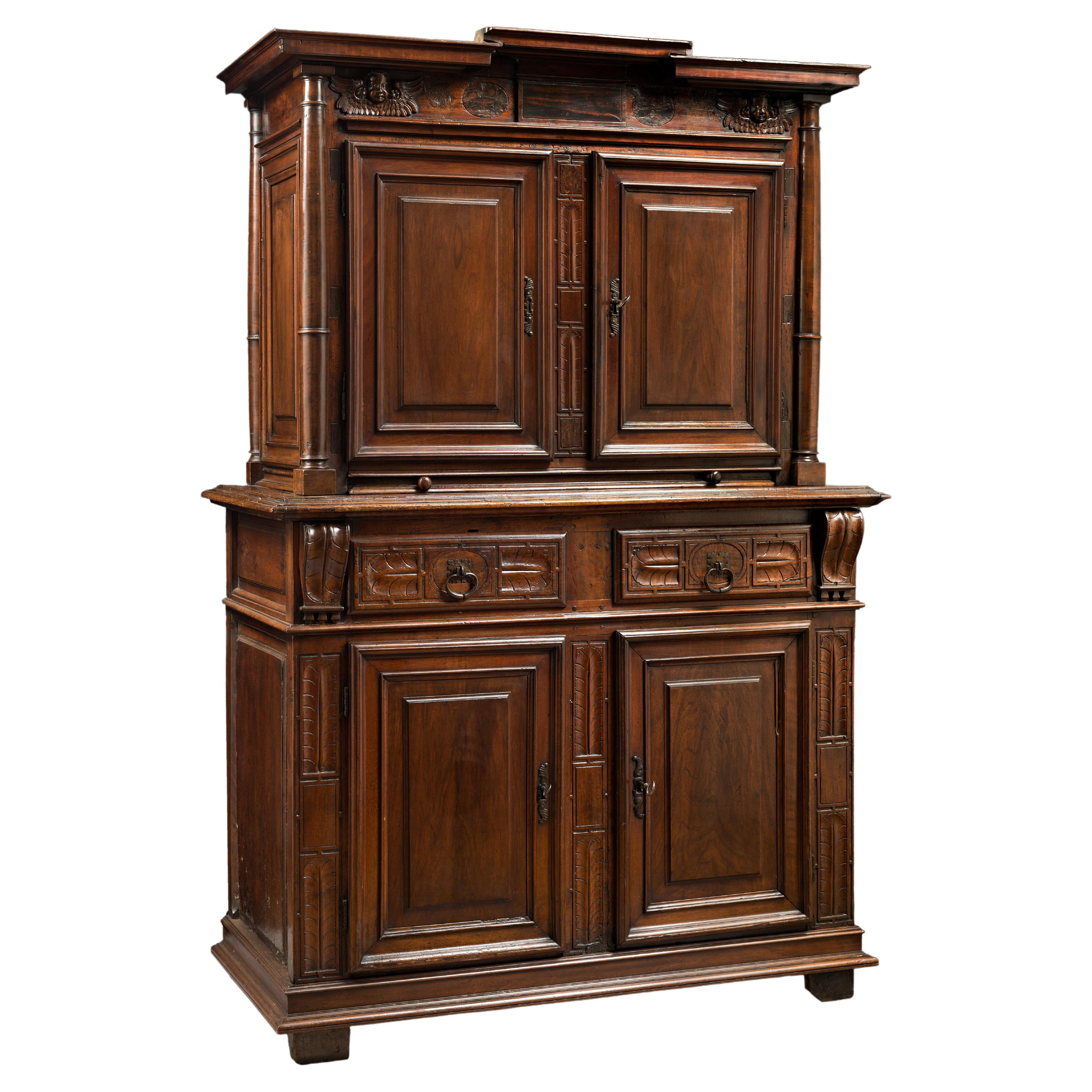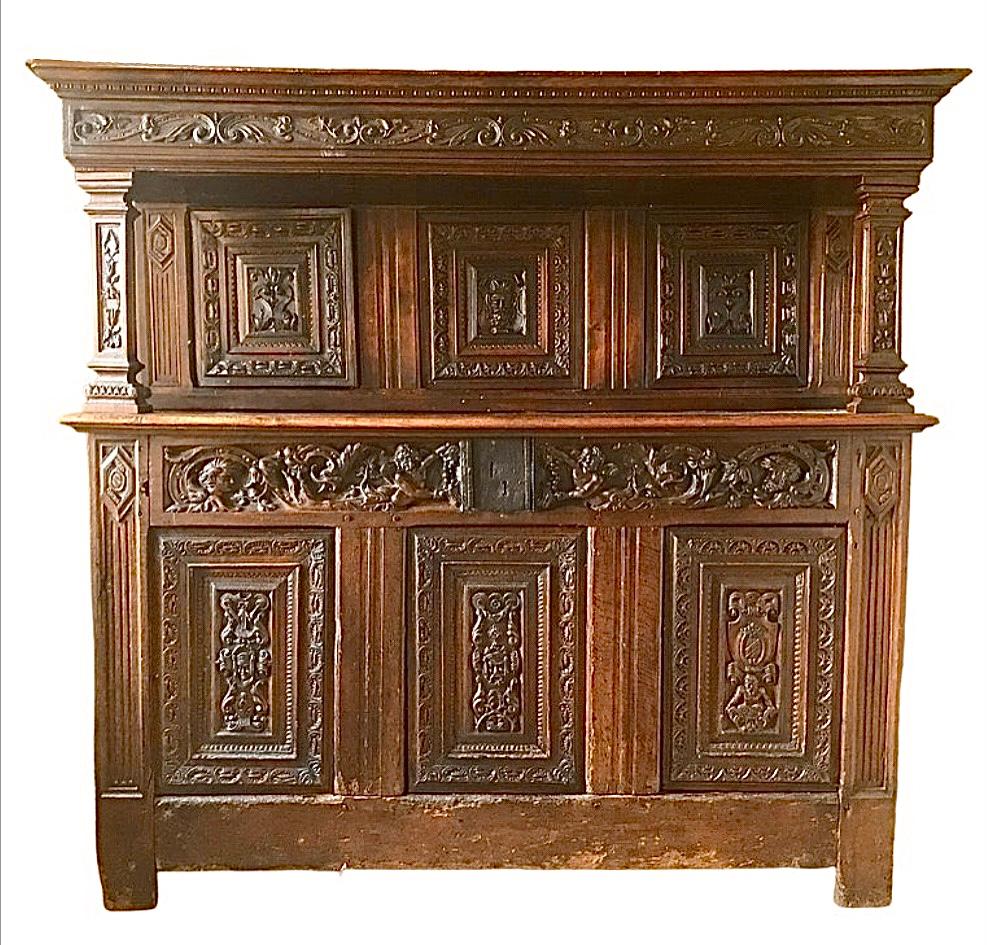Items Similar to Very Rare and Important 16th C. French Renaissance Cabinet or Dressoir, ca. 1580
Want more images or videos?
Request additional images or videos from the seller
1 of 8
Very Rare and Important 16th C. French Renaissance Cabinet or Dressoir, ca. 1580
About the Item
Walnut with verde antico marble inlay, with two wholly carved draped female allegorical figures within arched recesses, and a bas-relief on the central door. Rich and heavily carved sculptural ornamentation includes pilasters, columns, arches, caryatids, pediments, rinceaux, scrolls, garlands, dolphins, putti, and a grotesque mask. Incredibly, the cabinet retains nearly all of its original period elements. It is constructed in two parts, with the upper cabinet containing three compartments with locking doors, and the lower stand fitted with a frieze drawer above four columns tapering slightly at the top and bottom, resting on a rectangular plinth with moulded edge and bun feet.
The intricate carving of classical relief figures and inlaid marble panels which adorn this cabinet are characteristic of the French mannerist style employed by craftsmen of the seconde école de Fontainebleau dating from the late 16th century. Inspired by the work of the Italian artists Rosso Fiorentino, Primaticcio and Cellini who worked for François I at the Château de Fontainebleau in the 1530s and the ornamentalists who had assimilated these influences, such as Jacques Androuet du Cerceau (1510-1584) and Jean Goujon (1515)-1562), the architect, sculptor and cabinetmaker Hugues Sambin (ca. 1520 – 1601) borrowed freely from this répertoire of design for the adorment of furniture. Androuet du Cerceau’s flamboyant and splendidly-fashioned furniture was characterized by the use of bold human figures and by surfaces completely covered with carving.
Related examples are in the collections of the Getty Museum, the Victoria & Albert Museum and the Louvre.
For a similar illustrated example, please see:
M. Riccardi-Cubitt, The Art of the Cabinet, London, 1992, page 26, ill. 2
References:
Ruth Constantino, French Antiques, Clarkson Potter, 1961
Alain Erlande-Brandenburg, catalog of the exhibition Hugues Sambin: Un Créateur au XVIe siècle (vers 1520-1601) at the Musée National de la Renaissance, Château d'Écouen, October 2001 – January 2002
Simon Jervis, Printed Furniture Designs before 1650, Furniture History Society
Jacques Thirion, Mobilier Moyen Age Renaissance en France, Editiyons Faton.
Sir Francis Watson, The History of Furniture, Crescent Books, 1976
- Similar to:Jacques Androuet Du Cerceau (Maker)
- Dimensions:Height: 61 in (154.94 cm)Width: 49 in (124.46 cm)Depth: 18 in (45.72 cm)
- Style:Renaissance (Of the Period)
- Materials and Techniques:
- Place of Origin:
- Period:
- Date of Manufacture:c. 1580
- Condition:Wear consistent with age and use.
- Seller Location:Kensington, MD
- Reference Number:
About the Seller
5.0
Vetted Seller
These experienced sellers undergo a comprehensive evaluation by our team of in-house experts.
Established in 1962
1stDibs seller since 2013
137 sales on 1stDibs
- ShippingRetrieving quote...Ships From: Miami Beach, FL
- Return PolicyA return for this item may be initiated within 14 days of delivery.
More From This SellerView All
- 16th Century Spanish Cast Bronze Apothecary MortarLocated in Kensington, MDThis rare example of a Renaissance bronze mortar is decorated with starbursts all along the everted rim and features 4 large starbursts on the sides between the ribbed handles. The c...Category
Antique 16th Century Italian Renaissance Urns
MaterialsBronze
- Bronze Figure of Narasimha, South India, 16th-17th CenturyLocated in Kensington, MDThe lion-headed deity seated on round base over a stepped platform. Lakshmi seated on his left thigh, his principal hands holding a mace and lotus bud and upper hands holding a chakr...Category
Antique Early 17th Century Indian Tribal Figurative Sculptures
MaterialsBronze
- Oval Dish with Winged Putti, After Bernard Palissy, French, 17th CenturyBy Bernard PalissyLocated in Kensington, MDFrench glazed earthenware bowl in the manner of Bernard Palissy. Bernard Palissy (1510-1590) was a French potter who created extravagant glazes on his rustic ceramics...Category
Antique Mid-17th Century French Renaissance Ceramics
MaterialsEarthenware
- Collection of 4 Vintage Pharmacy Mortars, Bronze and Marble, 17th-20th CenturyLocated in Kensington, MDCharming collection of 4 vintage European bronze, brass and marble pharmacy and herbalist mortars ranging in age from the 17th-20th century. Each shows evidence of working use. Rangi...Category
Antique 17th Century British Renaissance Urns
MaterialsMarble, Brass, Bronze
- Rare Bronze Portrait Bust of Henri IV after Model by Barthelemy Prieur, c. 1800By Barthélemy Prieur 1Located in Kensington, MDThis handsome bronze portrait bust of the French King Henri IV is based on a model by Barthelemy Prieur (1540-1611) depicting the King nude as the Ro...Category
Antique Early 19th Century French Renaissance More Furniture and Collect...
MaterialsBronze
- Rare Bronze Indian Firecracker Cannon of Tiger Form, 18th CenturyLocated in Kensington, MDA beautifully designed early fireworks or flare cannon in tiger form. A small hole is drilled at the top rear of the cannon for the wick. In India, firecrackers and fireworks are tr...Category
Antique Late 18th Century Indian Tribal Figurative Sculptures
MaterialsBronze
You May Also Like
- 16th Century French Carved Renaissance CabinetLocated in Saint-Ouen, FRRare carved Renaissance cabinet Period : 2nd half 16th century, ca. 1570 Origin : France, Burgundy or Languedoc This cabinet embody the produ...Category
Antique 16th Century French Renaissance Cabinets
MaterialsWalnut
- 16th Century Renaissance Two-Bodied CabinetLocated in Saint-Ouen, FRFormer collection Altounian At the beginning of the reign of Henri II (1547-1559) the furniture’s ornamentation evolves. The few medieval motifs that were still used are eventually relinquished. Furniture becomes more sober showcasing moulded panels and perfect architecture. Cabinet-makers use ornaments such as curved fluted or plain columns, feather quills, roses or winged putti heads. High-relief carving becomes more scarce and compositions lighter. To that end cabinet-makers draw inspiration from Fontainebleau motifs filtering them and adapting them to French taste. During this period cabinet-makers turn into a kind of architects. Indeed the architectural balance of furniture is the centre of their concerns. The study of Antic formulas is then a necessity. From this care given to proportions appear refined cabinets with pure lines. This style is characteristic of the reign of Henri II and disappears soon after under the regency of Catherine de Medici (1560-1574) when an abundance of high and low-relief ornaments comes back on furnitures. This two-bodies cabinet...Category
Antique 16th Century French Renaissance Cabinets
MaterialsWalnut
- French late 16th century Renaissance Walnut Deux-Corps cabinetLocated in Troy, NYBeautiful French Renaissance cabinet in two parts. The top part with two carved doors featuring classical figures opening to an interior fit...Category
Antique 16th Century French Renaissance Cabinets
MaterialsWalnut
- French Buffet-Credence Cabinet Deux Corps Renaissance 16th Century FranceLocated in Beuzevillette, FRImportant Renaissance sideboard-credence. This piece of furniture, originally a very large chest from the 16th century chest from the 16th century has three panels carved with mascar...Category
Antique 16th Century French Renaissance Buffets
MaterialsWood
- 16th Century Spanish Walnut and Boxwood Table Cabinet, Circa 1580Located in Brugge, BEAn exceptional 16th Century Spanish walnut and boxwood table cabinet from Catalonia, also known as an arquilla. The fall is richly inlaid with bone, creating a decorative scene of tw...Category
Antique 16th Century Baroque Cabinets
MaterialsBoxwood, Walnut
- French Renaissance Henry II Late 16th Century Walnut Deux-Corps CabinetLocated in Troy, NYFrench Henry II Deux-Corps cabinet, in two parts. Of linear design and interesting, unusual proportions, the top part with two-doors over two drawers, bottom with two larger drawers ...Category
Antique 16th Century French Renaissance Cabinets
MaterialsWalnut
Recently Viewed
View AllMore Ways To Browse
History Of Furniture
Antique Furniture History
Rare And Important
Important Museum Antique
16th C
18th C Door
Antique Museum Cabinet
26 In Cabinet
Very Rare Books
Classical Relief
Antique French Inlaid Cabinet
Cabinet Inlay Rare
Black Cabinet On Stand
French Antique Cabinet Black
Important Rare Cabinet
Catalog Case
Antique Cabinet With Carved Columns
Inlay Cabinet With Lock





